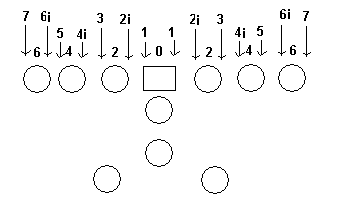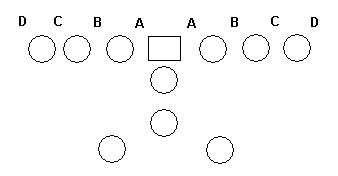This post is for all of you young players learning to play this great game or for those fans who want to understand a bit more of what those football announcers are talking about.
Consider the scenario… Coach looks over at you and says ‘Line up in a 4i if there is a tight end in the game.’ Huh? I am supposed to do what? Where am I supposed to be? Sprechen Sie Deutsch? 🙂 Well this blog post is here to help you start speaking the same language your coach (or football announcer) is speaking.
The language of football is very important. In order to communicate quickly and clearly there is a language to be learned. I used to tell my quarterbacks in the first days of fall camp that you need to quickly learn this language of football or we will not be able to effectively communicate. When my quarterback comes over to the sideline I will ask something like…
Are they in a 2i and 3? Or are they playing double 2is?
We don’t have time to waste. The letters and numbers tell a story very quickly. Both offensive and defensive players need to learn this language. So let’s get to it!
Basically to understand where a defensive player is lined up you are going to hear either…
- An Even Number (0, 2, 4, 6, 8) – This will mean the defensive player is going to be ‘heads-up’ on the offensive player.
- An Odd Number (1, 3, 5, 7, 9) – This will mean the defensive player is going to be ‘on the outside shoulder’ offensive player. Outside means on the shoulder away from the ball.
- An Even Number with an i after it (2i, 4i, 6i, 8i) – This will mean the defensive player is going to be ‘on the inside shoulder’ of the offensive player. The i stands for ‘Inside’ and means on the shoulder nearest to the ball.
Here is how it looks in a picture that is a lot more clear than words!

Note there are some coaches out there who call a ‘6i’ a ‘7’ and a ‘7’ a ‘9’. You just have to get used to what your coach/announcer is consistently describing. Here is one article that describes it as such as some of the original coaches that came up with these naming conventions.
Going back to the way I described the positions above you might also see the widest defensive player on the line, usually the ‘5’ or ‘7’, as being a ‘Tight 7’ or a ‘Wide 7’. This is trying to describe how close that player is to the offensive lineman. A ‘Wide 7’ might be trying to create some running space for a pass rush, while a ‘Tight 7’ might be really trying to get hands on the Tight End to protect his inside linebacker.
Note that this system can also apply to second level players like linebackers and third level players like safeties. You can do this by adding 1 or 2 extra zeros at the end to be really clear. So if the inside linebacker is supposed to line up on the outside edge of the guard we would tell him to line up in a ’30’ technique/alignment. That extra zero does not tell him how deep to line up, as linebackers can be anywhere from 2 to 6 yards off the ball, but at least it gets him in the right gap. I think saying something like ‘line up in a 2i0 technique’ would be a bit wordy, but it would make sense.
You can extend this to a safety position, where you could tell your free safety to line up over the guard on the TE side in a ‘200’ technique/alignment. This would be telling him to line up head-up over the guard at the third level. Again, this is not telling him if he should be 7 yards deep or 14 yards deep but it is a quick way to describe where he should be in relative position to the lineman. In the end, if you tell your LB or Safety to line up in a ‘3’, he would probably know what you mean even without the extra zeros. 🙂
There is a separate concept called ‘gaps’ that you will hear coaches talking about also. There are these gaps. There are two gaps of each letter on the left and right-hand side.
- A Gap – The area between the Center and the Guard
- B Gap – The area between the Guard and the Tackle
- C Gap – The area between the Tackle and the Tight End
- D Gap – The area outside the Tight End.
Here is an image of these gaps.

So if the defensive player lines up between the Center and the Guard there are basically three words we could use to describe where he is lined up.
- He is in a ‘1’ Technique. That means he is on the outside shoulder of the center.
- He is in the ‘A’ gap. That means he is lined up equally between the center and the guard. (This rarely happens. It most often happens in short yardage situations when penetration by the defensive line is very important.)
- He is in a ‘2i’. That means he is on the inside shoulder of the guard.
But coach? What if he is head-up on the center or the guard? Ah! Remember that those are the even numers.
- He is in a ‘0’. That means he is head up on the center and we might call him a nose guard then.
- He is in a ‘2’. That means he is head up on the guard. Many times if a defensive lineman is playing in a ‘2’ he will slant into a ‘3’ or ‘2i’. He does that so we do not know pre-snap what gap he is trying to control.
If you start to understand where these defensive lineman are going to line up, then you can many times start to place where the linebackers are going to line up, especially with an 8 man front. A typical 8 man front example is a 4×4 defense. This means there are 4 defensive lineman (the first number) and 4 linebackers (the second number). That will leave 11 – 8 = 3 secondary players which we usually call the safety and two corners. I should be able to tell an inside linebacker that he should simply line up in the open gap on his side of the ball. This will now mean that we will get a man to fill every gap if a team would try to run straight ahead. It might look like this…

Those quarter or half marks on the offensive players are trying to show you what ‘shade’ the defensive player is in. So as we learned above we have a ‘5’ and a ‘2i’ on the left, and we have a ‘3’ and a ‘6i’ on the right. Now notice where the linebackers are lined up. They are in the open gaps that the defensive lineman have not filled.
You might say that both the E and B on the left side are in the same ‘C’ gap, but sometimes we think of that running back behind the tackle as creating another gap like the TE clearly would. So the E is really in ‘C’ gap and the B is really in ‘D’ gap. On the offensive side we could also align the running back on the right side outside the TE to create another gap also. I just put him there because I typically like him in his normal Flexbone position so his blocking and motion footwork is always the same.
When watching a game you might see a linebacker hitting the hip of the defensive lineman telling him to move to a new position/shade. The defensive lineman might be in a ‘3’, which might be the wrong spot from what was called in the huddle, and the linebacker may hit his hip and be saying ‘Move to a 2i’. That is a lot more effective than saying ‘Move to line up on the inside shoulder of the guard’. If fact, he should simply need to say ‘2i’ and everything should be clear!
One drawback to this language I have always thought is that if I say somebody is in a 2i, I do not know if that person is on the left or the right. Maybe this language could evolve where we would sometime say L2i or R2i to quickly describe the side of the line. Then maybe my quarterback could say to me… Coach, they are in a L1 and R3. That could be really effective.
Learning a new language is fun! I hope this post has clarified this part of the football lingo for you.
Thanks for reading!
Please follow me on Twitter and like my Facebook page so you can get my latest blog posts!
Upside is a free app that gets you cash back on gas! I drive a lot. It saves me money on each fill-up AND it shows me the best local gas prices. Use promo code TERRY283468 to get an extra 15¢/gal bonus on your first purchase. https://upside.app.link/TERRY283468